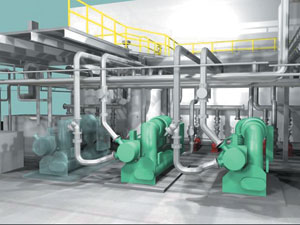New software advances have much in store for the building services engineer, says Pete Baxter (below), sales director, Autodesk Building Solutions Division
TECHNOLOGY moves at a great pace. After all, if somebody had said 10 years ago that by 2006 almost everybody would have a mobile phone you may have been surprised.
It's the same in the building and building services industries. What seems radical now will very quickly become the norm. You may once have thought that IT didn't have a role in the world of a heating engineer. But many in the business now think nothing of using software such as AutoCAD to design their schemes.
So what's on the horizon - and what will be the standard tools of the trade in the future?
New trends promise greater efficiency, accuracy, productivity and even sustainability for a start. These innovations are already producing better quality buildings with a lower total cost of ownership. But they do involve a change in thinking.
Let's take a closer look at the developments.
2D to 3D
Designing in 3D is rapidly becoming the norm across the architectural world. For example, we know that in 2005 two and a half times as many architects used Autodesk Revit Building, Autodesk's main 3D building design software, than they did 12 months before.
This is a move that building services engineers can't ignore. But until recently, there have been good reasons for them to stick to 2D.
Traditionally, engineers have relied on conventional drawings or 2D digital data from architects from which to develop the services design. It is only relatively recently that 3D digital data has been available for use by the project team. In addition, training and implementation overheads associated with the introduction of complex 3D systems have been difficult to justify commercially.
Autodesk Building Systems (ABS) is specifically aimed at the building services engineer. As it is based on AutoCAD and Architectural Desktop (ADT), it enables engineers to work in a familiar 2D environment, as well as in 3D, so they can choose the most appropriate way of working for each project.
In fact, it means that moving to 3D is essentially an evolutionary development. For example, preliminary sketches for most designs may continue to be in 2D format. By quickly switching to a modelling environment, however, users can more effectively test and validate their initial concepts. The software therefore fully supports the conventional 2D AutoCAD workflow, but also eases the transition to a 3D modelling environment
Designing in 3D entails a shift from working with arcs and circles to working with 3D library components. Instead of simple 2D graphics, extensive standard equipment libraries of UK-specific components such as ducts, grilles and pipes now enable quick assembly of 3D models.
In this environment, co-ordination of drawings is automated and plans and sections are generated from the same data. In addition, parts of the design process can be automated through the functionality of the 'intelligent' objects. So, when a valve is inserted into a pipe run, for example, the pipe run will 'self heal' around the inserted object. The editing of lines and arcs necessary in a purely 2D system is no longer required.

When an engineer uses a BIM tool such as AutoDesk, it will create a central model which represents the state of the design
Moving beyond 3D
Even if you usually throw up your hands at yet another three letter acronym, BIM is one to remember. It stands for Building Information Modelling and is set to change the industry far more than 3D design alone.
BIM isn't a new technology but a practical working methodology. To understand BIM you need to recognise that 3D is not just about producing images, or even models of a design.
When you use a BIM tool such as Autodesk Revit Building, a comprehensive database sits behind the model. Every drawing sheet, 2D and 3D view and schedule is a direct presentation of information from the same underlying building database. As the architect or engineer designs, the underlying database, the central core of the software, manages change across the whole project.
In simple terms, a piece of ductwork may appear on many plan, section, elevation and detail drawings at a range of output scales. However, the duct exists once in the 3D central model. Any change made to the model will instantly update all drawings on which the component features.
As a result, it is possible to create a single central model which represents exactly the current state of the design. Revit Building allows multiple users across disciplines to work concurrently in the same model.
All professions working on the design - including architects, structural and building services engineers - can then collaborate on the same single model, reducing co-ordination errors. It also allows services engineers to be involved in the design process at a much earlier stage. They can then, therefore, influence the design to optimise the services installation to the ultimate benefit of the client and building users.
Autodesk 3D products, ADT and ABS have been deployed on a range of major global projects such as BAA's new Terminal 5 at Heathrow, while Revit Building has been the BIM solution chosen for the design of The Freedom Tower, the first new building on the World Trade Centre site in New York.
However, this spring Autodesk announced it was extending its Revit platform which enables BIM to include both Autodesk Revit Structure and Autodesk AutoCAD Revit Systems - the latter designed especially for building services. Autodesk believes the introduction of these discipline-specific BIM solutions will actively encourage closer integration of all the design disciplines and lead to more effective design teams and efficient design solutions.
Until now heating and ventilation engineers have been held back by lack of the right software. Now there is nothing stopping them.